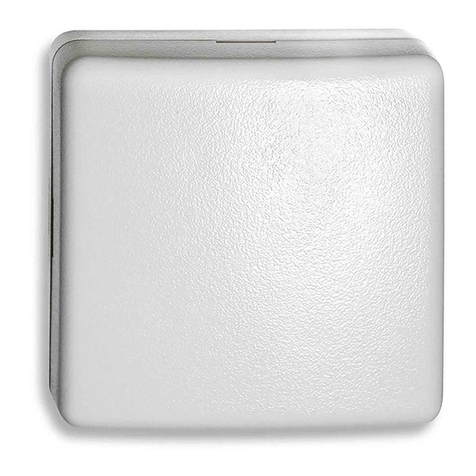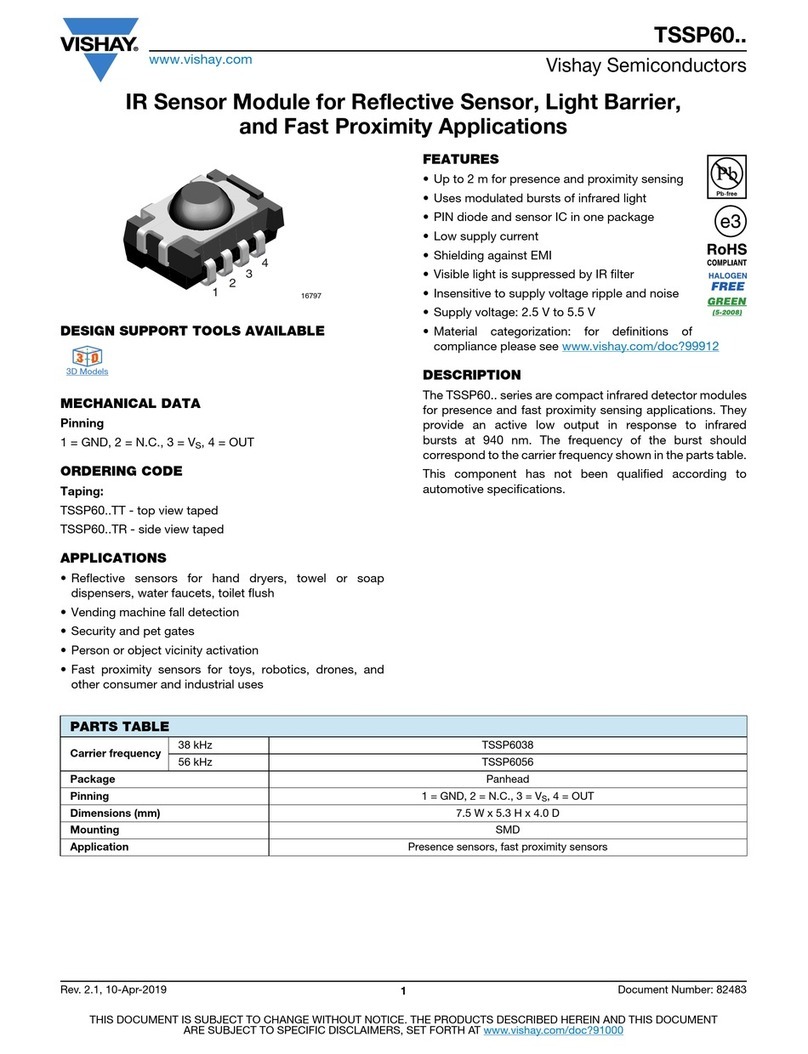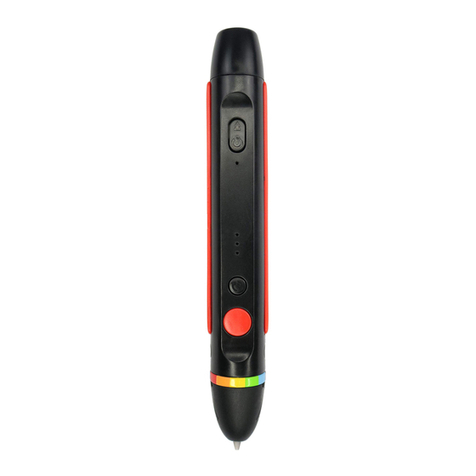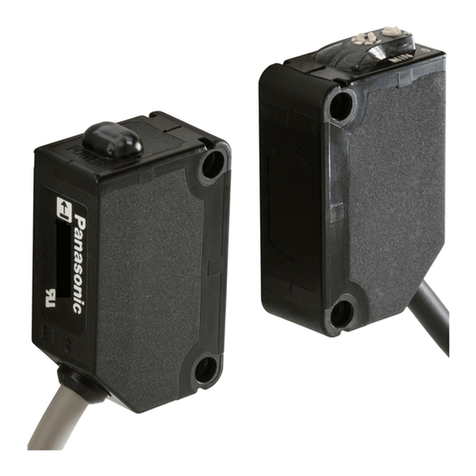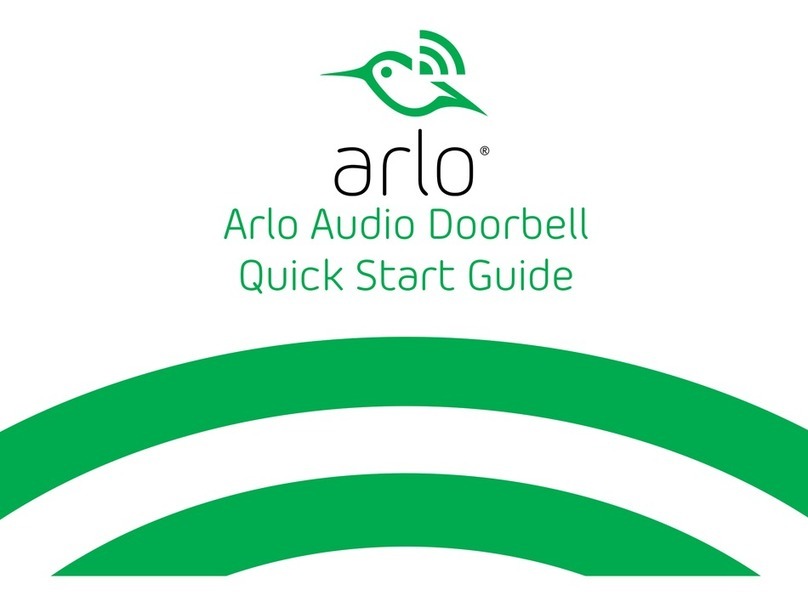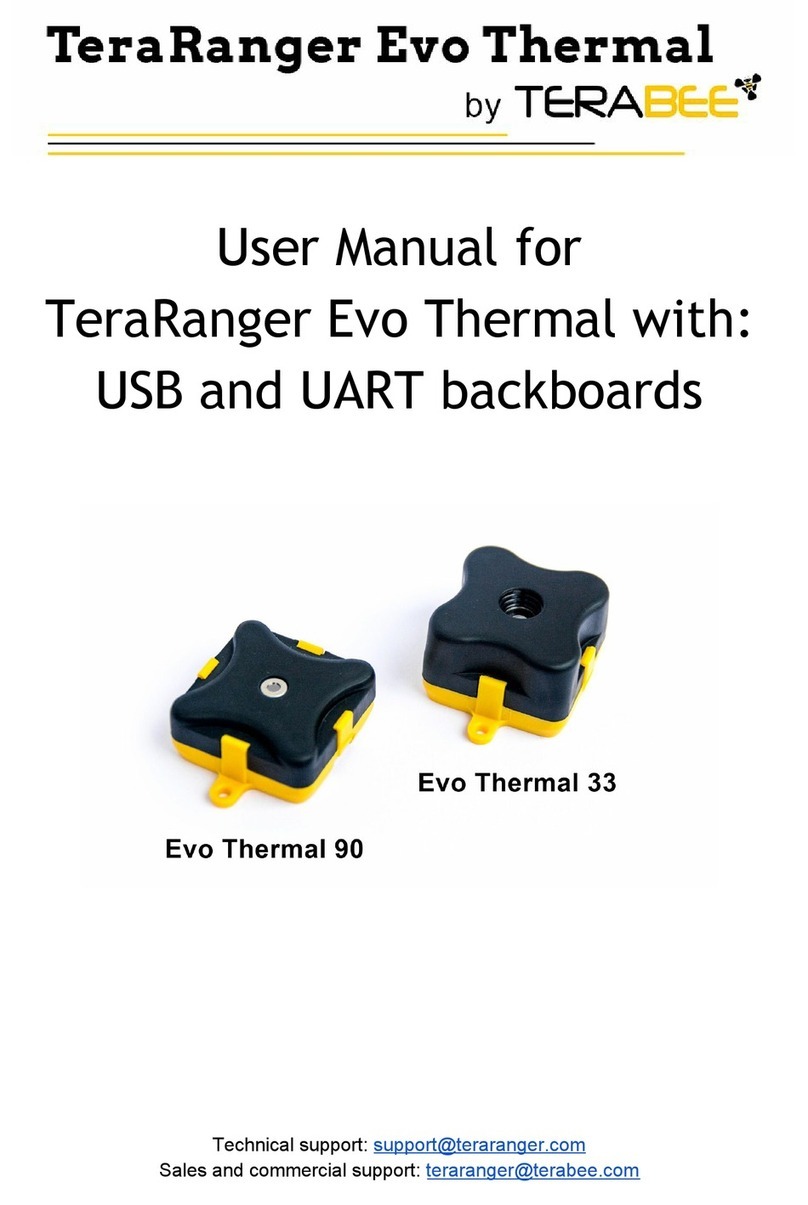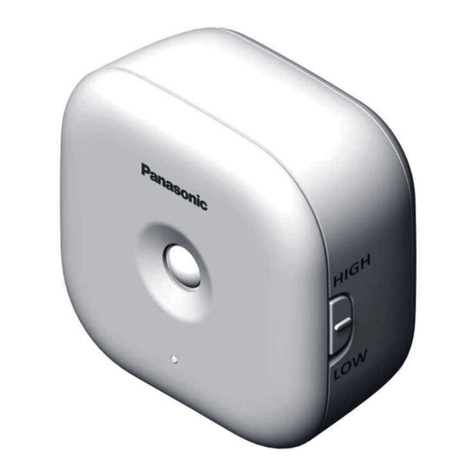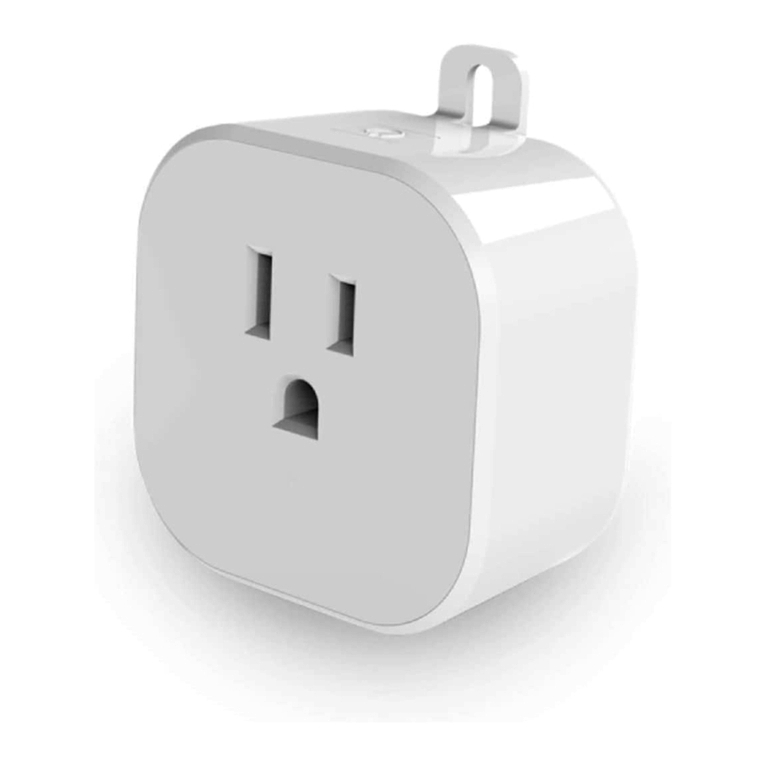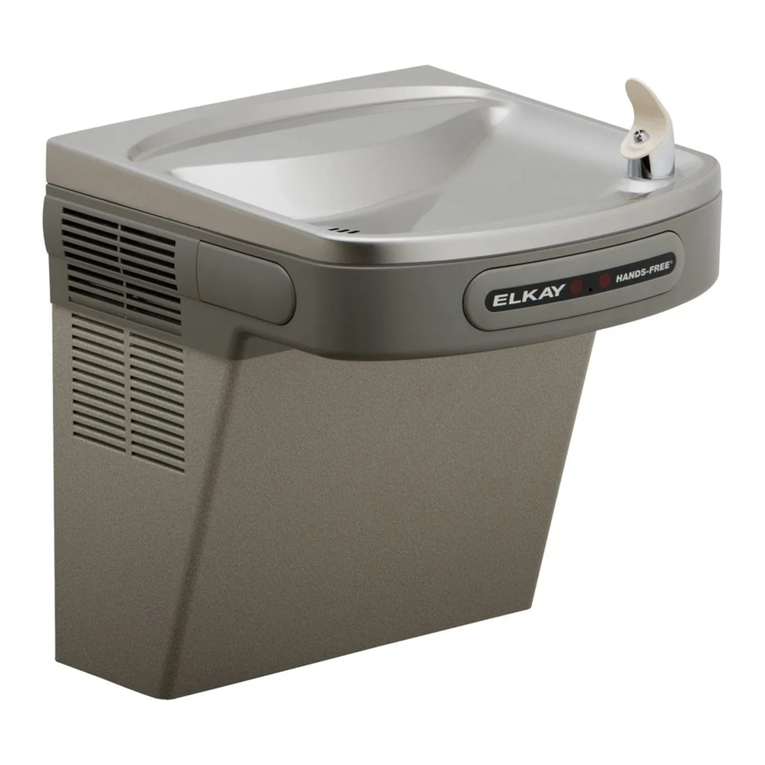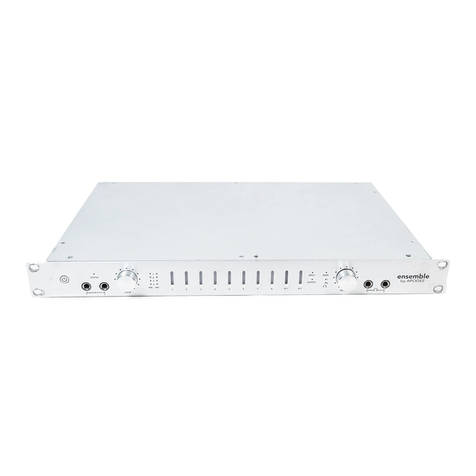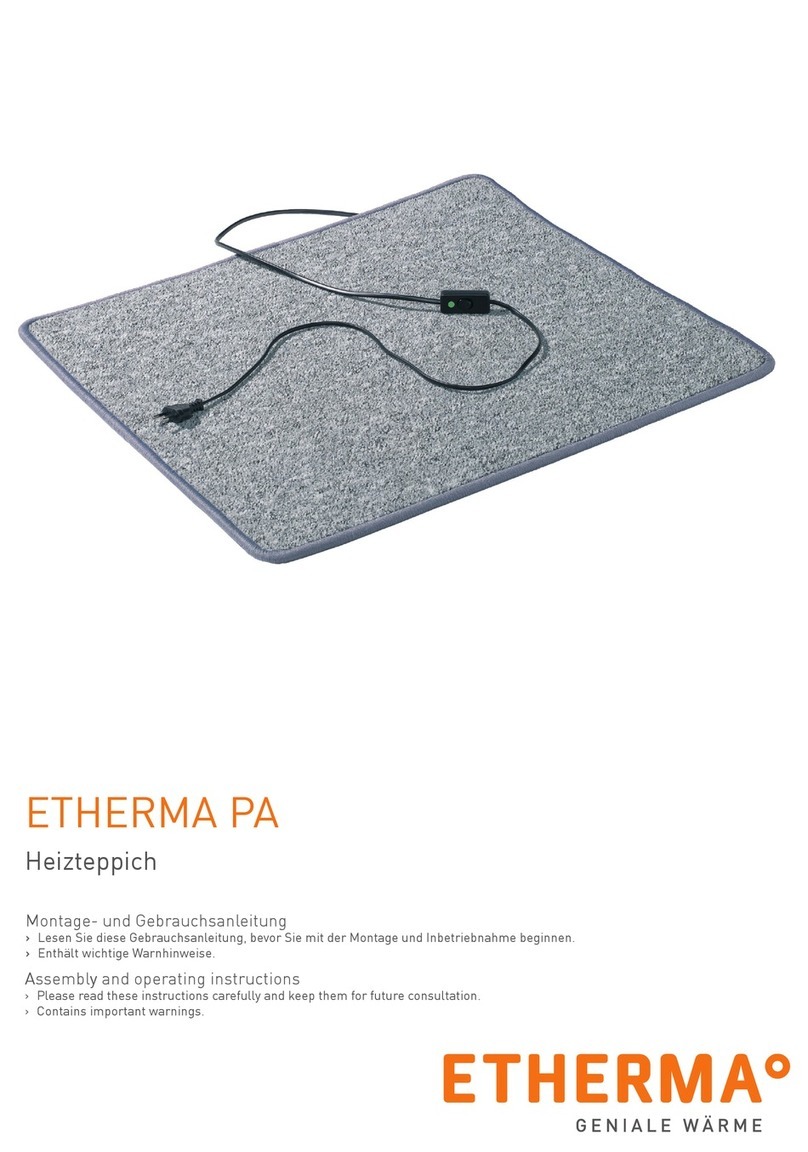SENSIRION SCD4 Series User manual

www.sensirion.com Version 1 –January 2021 1/5
Handling Instructions
For SCD4x CO2Sensors
1ESD protection
The sensor shall be protected from ESD (Electrostatic
Discharge) and only be handled in ESD protected areas
(EPA) under protected and controlled conditions (ground
all personnel with wrist-straps, ground all non-insulating
and conductive objects, exclude insulating materials
from the EPA, operate only in grounded conductive floor,
etc.). Protect sensor outside the EPA using ESD
protective packaging.
Protection against ESD is mandatory.
2Mechanical handling
As the SCD4x is an optical system, it must not be
exposed to extreme mechanical forces at any time. Wear
clean gloves or finger cots while handling the sensor and
avoid touching the white protection membrane.
Furthermore, no excessive force must be applied to the
protection membrane on top of the metal cap. Damage
to the protection membrane such as partial removal or a
minor cut will make the sensor irreversibly defective.
Finally, the sensor must not be exposed to strong air
blasts from an air-pistol.
3Exposure to Chemicals
Some solvents might cause the protection membrane to
peel off the metal cap which results in an irreversible
defect of the SCD4x sensor. Furthermore, the SCD4x
comprises a best-in-class Sensirion relative humidity
(RH) and temperature (T) sensor that must be protected
from pollutants. While ambient environments are usually
not critical for the sensor, pollutants are known to occur
in manufacturing environments and may occur during
storage and by packaging materials. Please carefully
follow the guidelines in this application note to ensure
that the performance of the built-in RH/T sensor is not
compromised. Note that preserved accuracy of the RH/T
sensor is required to ensure precise CO2readings over
the entire relative humidity and temperature range –
even if the RH and T output is not used in the application.
The sensor shall not get in close contact with volatile
chemicals such as solvents or other organic compounds.
Especially high concentration and long exposure must
be avoided. Ketenes, acetone, ethanol, isopropyl
alcohol, toluene, etc. are known to cause drift of the
humidity reading –irreversibly in most of the cases.
Please note that such chemicals are integral part of
epoxies, glues, adhesives, etc. and outgas during baking
and curing. These chemicals are also added as
plasticisers into plastics, used for packaging materials,
and do out-gas for some period.
Acids and bases may affect the sensor irreversibly and
shall be avoided: HCl, H2SO4, HNO3, NH3etc. Also
ozone in high concentration or H2O2have the same
effect and therefore shall be avoided. Please note that
above examples represent not a complete list of harmful
substances.
The sensor shall not get in contact with cleaning agents
(e.g., PCB board wash after soldering). Applying
cleaning agents to the sensor may lead to drift of the
reading or complete breakdown of the sensor.
Preface
For taking advantage of the SCD4x outstanding
performance, some precautions must be taken during
storage, assembly and packaging. Please read the
following instructions carefully - preferably during design-
in phase and before production release of the respective
device.
The protection membrane on top of the metal
cap must not be removed or damaged.
No excessive shear force must be applied to the
metal cap.
The sensors in SMD packages are classified as
Moisture Sensitivity Level 3.
Prolonged exposure to high concentrations of
volatile organic compounds such as solvents
should be avoided.

www.sensirion.com Version 1 –January 2021 2/5
Ensure good ventilation (fresh air supply) to avoid high
concentrations of volatile chemicals (solvents, e.g.
ethanol, isopropanol, methanol, acetone, cleaning
solutions, detergents…).
4Packing and Storage
The SCD4x is classified as Moisture Sensitivity Level 3
(IPC/JEDEC J-STD-020). Therefore, the sensor should
be mounted and reflowed within 1 week of exposure to
ambient room conditions (30° C / 60% RH maximum).
Prior to assembly or use of the sensors it is strongly
recommended to store the sensors in the original sealed
bag with temperatures in the range of 10°C –50°C.
Store sensors in original, unopened ESD bag. Place
additional stickers only on the outside of the ESD
bag.
Once sensors have been removed from the original ESD
bag we recommend storing the individual sensors as well
as devices with assembled sensors in antistatic shielded
ESD bags at normal pressure (i.e. bag should not be
evacuated). In particular, it is recommended not to use
any adhesive or adhesive tapes to reseal the sensor bag
after opening. The following ESD bags can be
recommended (no polluting effect on humidity sensor):
ESD Bag
Manufacturer
Product
Stroebel
"Topshield" Bags
Sensors as a component or mounted into the final
product shall not be packaged in outgassing plastic
materials. Please note that many packaging materials
may be contain additives (plasticizers) which may have
a polluting effect on the sensor. Generally speaking, if a
material emits a strong odour you should not use it.
1
Humidity sensor handling instructions:
www.sensirion.com/file/handling_instructions_rht
Besides metal-in antistatic shielded ESD bags, paper or
cardboards based packaging, deep drawn plastic trays
(PE, PET, PP) may be considered. Do not use antistatic
polyethylene bags (light blue, pink or rose colour); be
very careful with bubble foils and foams. Be careful about
stickers present inside the packaging (e.g., on the
housing of the device).
Do not use polyethylene antistatic bags (light blue,
pink or rose colour). Do not use adhesive tapes
inside packaging.
For guidance on simple and straight-forward testing of
SCD4x CO2sensors please consult the corresponding
“Testing Guide”. Furthermore, the humidity sensor
handling instruction lists some encapsulants and
adhesives that do not contaminate the integrated
humidity sensor
1
.
5Assembly
Before fixing the assembly process parameters, please
read the datasheet carefully.
5.1 Pick and place process
The SCD4x footprint, landing pads and the tape & reel
dimension are illustrated in the SCD4x datasheet. Note
that pins are numbered according to IPC standard with
pin 1 having a rounded edge. Subsequent pins are
counted upwards counter-clockwise (top view). On the
front side of the SCD4x, an edge of the membrane
serves as the polarity mark, indicating pin 1.
To avoid damage, the SCD4x should be picked in the
centre of protection membrane with a nozzle that has a
plastic contact area (see schematic below). The touch
down force of the nozzle should be tuned to a value such
that the nozzle leaves no permanent mark on the
SCD40 –600pcs
Inspected

www.sensirion.com Version 1 –January 2021 3/5
membrane (typically < 5 N). Finally, the outer diameter
of the nozzle should be smaller than 4.4 mm.
SCD4x P&P nozzle contact area. The edge in the
protection membrane serves as a polarity mark
indicating the pin 1 mark on the backside of the PCB.
5.2 Sensor reflow soldering (SMT)
Standard reflow soldering ovens are recommended for
the soldering process. A soldering profile is illustrated in
the SCD4x datasheet. Make sure that maximum
temperatures and exposure times are respected. In case
the PCB passes through multiple solder cycles (as is the
case for e.g. PCBs that are assembled on top and
bottom side), the SCD4x must be assembled in the last
solder cycle. Subsequent manual soldering of other PCB
components (e.g. through-hole soldering) has no impact
as long as the SCD4x is not exposed to temperatures
higher than 200 °C. The sensor shall be mounted into
the device, if possible, after all materials that are used in
the assembly process have completely cured or dried
out. Otherwise ensure good ventilation (fresh air supply)
in curing ovens and assembly lines. Not respecting these
guidelines can result in non-reversible and / or reversible
change of calibration (i.e. offset of the CO2signal, which
can be corrected by applying a FRC). See SCD4x
Datasheet
2
and Testing Guide Application Note
3
for
more information on recalibration procedure).
The SCD4s is not compatible with vapour phase reflow
soldering.
5.3 Rework process
Manual hand soldering / de-soldering of the SCD4x must
only be done with solder equipment that allows precise
temperature control. Temperatures higher than the
specified peak temperature in the SCD4x datasheet can
result in a sensor defect or can compromise SCD4x
sensor performance, even if heat exposure is very local
and limited in time. Furthermore, no force must be
2
www.sensirion.com/file/datasheet_scd4x
applied to the metal cap or the protection membrane
during rework process.
Do not apply board wash after the sensor is assembled
onto the PCB. Furthermore, be particularly careful when
using strong cleaning agents (e.g. detergents, alcohols,
brominated or fluorinated solvents) during rework
processes as they might compromise the membrane
adherence.
Do not apply board wash.
6Conformal Coating
Active components of the SCD4x are shielded from
environmental influences by the metal cap and the
protection membrane. Therefore, conformal coating of
the SCD4x is not necessary for most applications.
If a conformal coating is applied anyways, there are
some important aspects that must be respected to
prevent sensor failure or diminished performance.
If conformal coating is applied, the top surface of the
sensor (protection membrane) must remain free of
coating.
3
www.sensirion.com/file/scd4x_testing_guide
XXX

www.sensirion.com Version 1 –January 2021 4/5
Most importantly, covering the protection membrane (top
of the sensor) with any kind of coating must be avoided.
This is because the membrane must remain permeable
to air molecules to ensure coupling to ambient. Note that
a thin layer of conformal coating is already enough to
fully block the sensors opening and thus destroying the
sensor. Furthermore, the membrane must not be
removed after the coating process.
The SCD4x is not compatible with spray coating and dip
coating. Manual coating with a brush, dispensing and
jetting can be used to apply conformal coating on the
PCB while ensuring that no coating is applied to the
membrane.
Do not apply spray to unprotected sensor.
Finally, a suitable coating should be selected that does
not contaminate the built-in humidity sensor. The
following table lists conformal coatings which have been
tested regarding pollution of the humidity sensor and are
known to be suitable if applied and fully cured under
good ventilation (fresh air supply) and according to the
respective datasheet.
Conformal Coatings
Manufacturer
Product
Peters
Elpeguard SL 1301 ECO-FLZ
Dow Corning
1-2577 Low Voc Conformal Coating
Electrolube
AFA (Aromatic Free Acrylic Conformal
Coating)
7Application in extreme environment
Some applications require the exposure to harsh
environments. Even though the sensor is uncritical to be
used in most cases, some precautions must be taken.
Regarding limits of exposure to extreme humidity and
temperature conditions please consult the SCD4x
datasheet.
If the SCD4x is used in condensing environments, it is
recommended to operate the sensor continuously in the
high performance mode. The induced temperature offset
reduces risk of condensation inside the optical cavity.
Exposure to volatile organic compounds at high
concentration and long exposure time is critical as this
could result in pollution of the built-in humidity sensor
resulting in offset of RH readings. Inaccurate RH
readings can compromise the CO2output accuracy due
to the built-in RH-compensation algorithm.
Exposure to acids or bases may be critical too. Etching
substances such as H2O2, NH3, etc. at high
concentrations are critical to the sensor as well. Such
application needs to be carefully tested and qualified.
Disclaimer
The above given restrictions, recommendations,
materials, etc. do not cover all possible cases and items.
The material recommendations are given regarding to
pollution of the built-in humidity sensor and assume
optimal processing for avoiding VOCs. The materials
were not tested regarding other properties like reliability,
performance, usability or mechanical properties. The
material recommendations have been compiled with our
best knowledge at the time of writing. Manufacturers may
change the compounds without notice, which can lead to
reduced Sensor performance due to outgassing.
This document is not to be considered complete and is
subjected to changes without prior notice.
Revision History
Date
Version
Page(s)
Changes
January 2021
1
All
Initial version

www.sensirion.com Version 1 –January 2021 5/5
Important Notices
Warning, Personal Injury
Do not use this product as safety or emergency stop devices or in any other application where failure of the product could result
in personal injury. Do not use this product for applications other than its intended and authorized use. Before installing,
handling, using or servicing this product, please consult the data sheet and application notes. Failure to comply with these
instructions could result in death or serious injury.
If the Buyer shall purchase or use SENSIRION products for any unintended or unauthorized application, Buyer shall defend, indemnify and
hold harmless SENSIRION and its officers, employees, subsidiaries, affiliates and distributors against all claims, costs, damages and
expenses, and reasonable attorney fees arising out of, directly or indirectly, any claim of personal injury or death associated with such
unintended or unauthorized use, even if SENSIRION shall be allegedly negligent with respect to the design or the manufacture of the
product.
ESD Precautions
The inherent design of this component causes it to be sensitive to electrostatic discharge (ESD). To prevent ESD-induced damage and/or
degradation, take customary and statutory ESD precautions when handling this product.
See application note “ESD, Latchup and EMC” for more information.
Warranty
SENSIRION warrants solely to the original purchaser of this product for a period of 12 months (one year) from the date of delivery that this
product shall be of the quality, material and workmanship defined in SENSIRION’s published specifications of the product. Within such
period, if proven to be defective, SENSIRION shall repair and/or replace this product, in SENSIRION’s discretion, free of charge to the
Buyer, provided that:
notice in writing describing the defects shall be given to SENSIRION within fourteen (14) days after their appearance;
such defects shall be found, to SENSIRION’s reasonable satisfaction, to have arisen from SENSIRION’s faulty design, material, or
workmanship;
the defective product shall be returned to SENSIRION’s factory at the Buyer’s expense; and
the warranty period for any repaired or replaced product shall be limited to the unexpired portion of the original period.
This warranty does not apply to any equipment which has not been installed and used within the specifications recommended by
SENSIRION for the intended and proper use of the equipment. EXCEPT FOR THE WARRANTIES EXPRESSLY SET FORTH HEREIN,
SENSIRION MAKES NO WARRANTIES, EITHER EXPRESS OR IMPLIED, WITH RESPECT TO THE PRODUCT. ANY AND ALL
WARRANTIES, INCLUDING WITHOUT LIMITATION, WARRANTIES OF MERCHANTABILITY OR FITNESS FOR A PARTICULAR
PURPOSE, ARE EXPRESSLY EXCLUDED AND DECLINED.
SENSIRION is only liable for defects of this product arising under the conditions of operation provided for in the data sheet and proper use
of the goods. SENSIRION explicitly disclaims all warranties, express or implied, for any period during which the goods are operated or
stored not in accordance with the technical specifications.
SENSIRION does not assume any liability arising out of any application or use of any product or circuit and specifically disclaims any and
all liability, including without limitation consequential or incidental damages. All operating parameters, including without limitation
recommended parameters, must be validated for each customer’s applications by customer’s technical experts. Recommended
parameters can and do vary in different applications.
SENSIRION reserves the right, without further notice, (i) to change the product specifications and/or the information in this document and
(ii) to improve reliability, functions and design of this product.
Copyright © 2021, by SENSIRION. CMOSens®is a trademark of Sensirion. All rights reserved
Headquarters and Subsidiaries
Sensirion AG
Laubisruetistr. 50
CH-8712 Staefa ZH
Switzerland
phone: +41 44 306 40 00
fax: +41 44 306 40 30
www.sensirion.com
To find your local representative, please visit www.sensirion.com/distributors
Other manuals for SCD4 Series
2
Table of contents
Other SENSIRION Accessories manuals
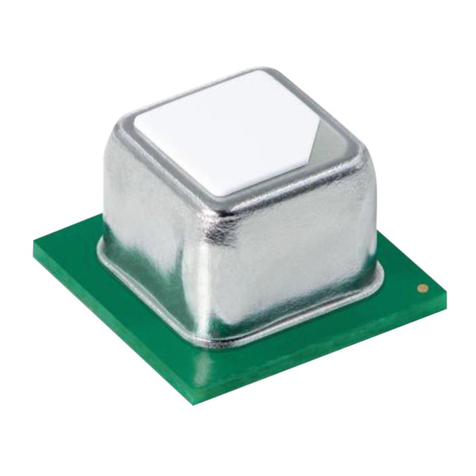
SENSIRION
SENSIRION SCD40-D-R2 User manual

SENSIRION
SENSIRION SCD42 User manual

SENSIRION
SENSIRION SHT4x User manual
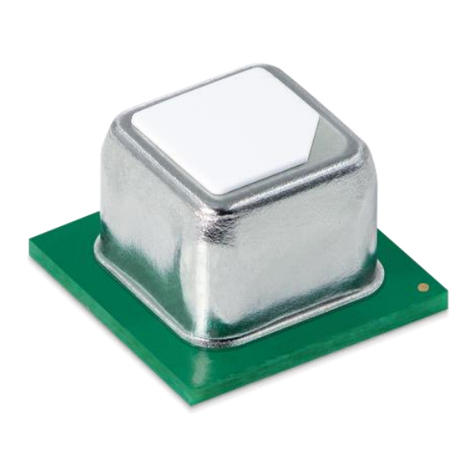
SENSIRION
SENSIRION SCD4x User manual
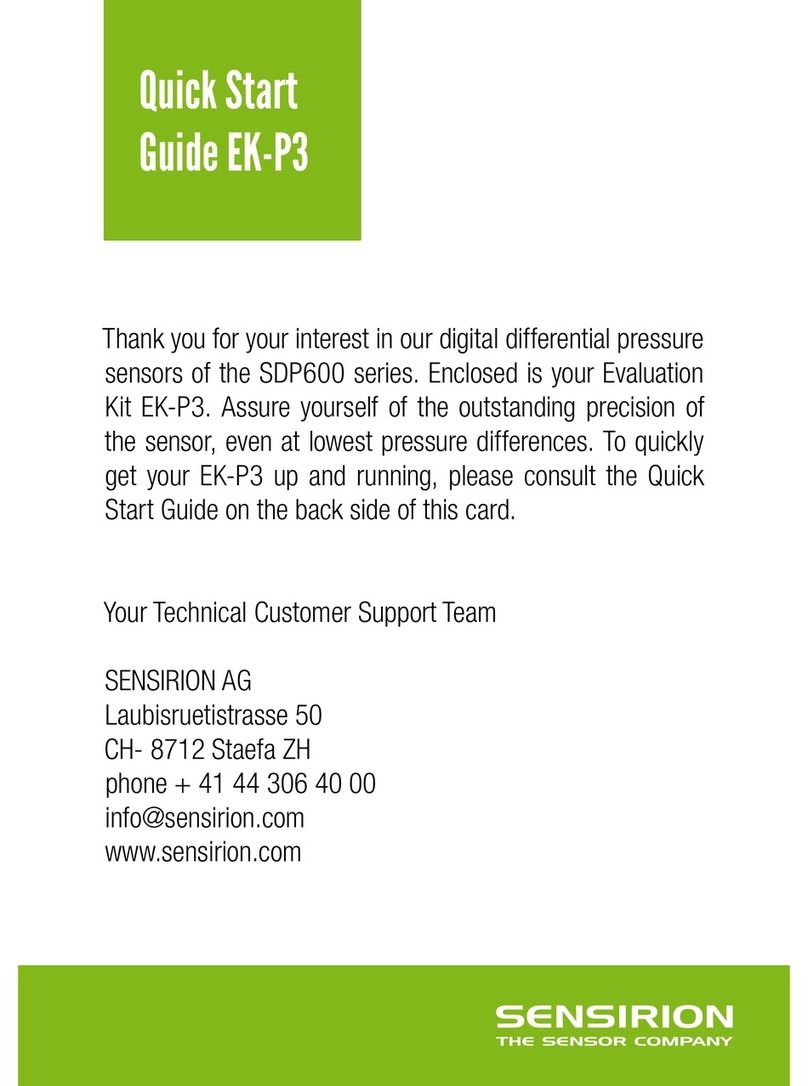
SENSIRION
SENSIRION EK-P3 User manual
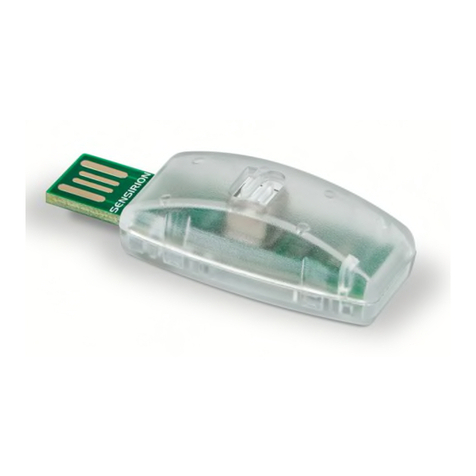
SENSIRION
SENSIRION SCD4 Series User manual
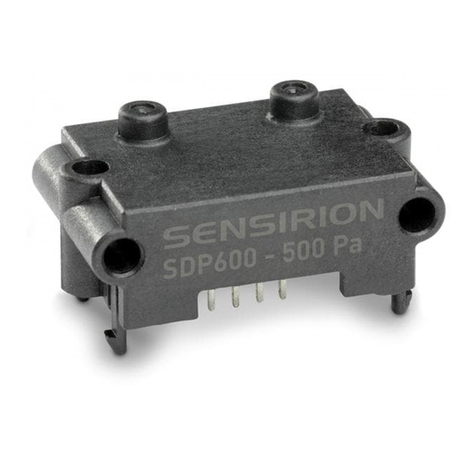
SENSIRION
SENSIRION SDP600 Series User manual
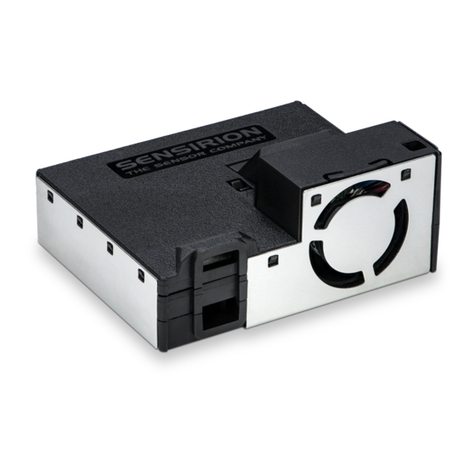
SENSIRION
SENSIRION SEN5 Series User manual
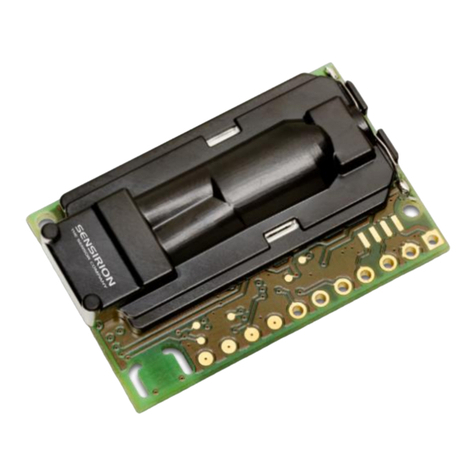
SENSIRION
SENSIRION SCD30 User manual

SENSIRION
SENSIRION LD20 Series Installation guide



